|
The 1680’s saw a very
tragic episode in the long and bitter struggle between Presbyterians
and Episcopalians. Like monarchs before him, King Charles II declared
himself king not only of his nation but also of the Church. He sought
then to impose Episcopal doctrine on every congregation in Scotland.
A century earlier, John
Knox, a Scottish disciple of the Reformer John Calvin, had taught the
supremacy of Christ over the Church for which He had died. Followers
of the Presbyterian faith in fact held to various National Covenants
which declared a firm determination to resist to the death the king’s
attempt to override “the Crown Rights of the Redeemer in His Kirk.”
Charles II responded to
the Covenanters with brutality. Soldiers were stationed in the homes
of men and women who would not attend the king’s kirks, robbing them
of food and possessions. Other homes were burned, fines were levied,
and men and women alike were brutally murdered and their bodies
sometimes desecrated. It was a bloody era which came to be known as
“The Killing Time.” A shepherd from Derry Farm, Wigtownshire, was
among its victims.
It was the spring of
1685. Alexander Linn tended his flock on the moor on Craigmoddie
Fell. While the sheep grazed quietly about him, he sat near the crest
of the hill and read his pocket Bible. Lieutenant-General William
Drummond, whose brutal, relentless pursuit of Covenanters had earned
him the nickname “Herod” Drummond, was leading his men across southern
Ayrshire. As they advanced toward Wigtownshire, a number of lapwings
flying in the distance suggested that some danger threatened their
nests. Suspecting the cause of their distress might be human,
Drummond led his men across the border. Approaching Craigmoddie Fell,
they saw someone near the top of the hill and circled around to take
him by surprise. When they found him in possession of a pocket Bible,
Drummond decided that was cause enough to condemn him. And so
Alexander Linn, a simple shepherd, was ambushed, shot, and killed for
his faith.
Later, when Linn’s
lifeless body was found, it was buried where he had died. The place,
described as “a bleak, romantic spot,” was marked by a memorial stone.
One hundred forty-two
years later, Rev. William Symington of Stranraer, Wigtownshire
conducted a memorial service at the grave of Alexander Linn. A wall
was built around the grave, its stone placed in the wall, and a second
stone added.
The tomb is in so
remote a place that Mackenzie wrote ... It was [a] matter of surprise,
that a congregation could be collected there to hear [a] sermon. ...
“Yet,” says an eye witness, “we had a large and most attentive
audience, people having gathered from a wide circle of the surrounding
country. It was with great difficulty that Dr. Symington could find
his way to the spot on the Sabbath morn; but as he approached it, he
perceived people streaming towards it from all quarters. A temporary
pulpit was erected near the martyr’s grave. The audience listened
with much pleasure, to a long and moving discourse, from Jude 3. An
Old elder from Ayrshire, officiated as precentor, and gave plaintive
martyrs worthy of the name ...’’
Sixty years after
Symington’s sermon, another memorial service was conducted at Linn’s
tomb. In twenty-four and twenty-five years more, yet another and
another. Eventually, a third stone was added to the wall,
commemorating the 1887, 1911, and 1912 services.
Additional
commemoration services were held at the tomb in 1972 and 1985, the
latter marking the 300th anniversary of the death of Alexander Linn.
The 1972 service was recorded by an addendum to his original 1685
stone in which two numbers in the date were transposed, reading 1927
instead of 1972.
On that spring day in
1685, what words of God were last on the heart and mind of Alexander
Linn as he read the scriptures? What promises of the Lord ushured him
into his heavenly home as he left his earthly abode? Inside his
tomb’s enclosure, a rose is growing. On the hills around, sheep still
graze.
1. The History of
Galloway from the Earliest Period to the Present Time, Rev. William
Mackenzie, Vol. 2, Kirkcudbright (1841)
2. Scottish
Covenanter Stories, Dane Love, Glasgow (2000)
3.
My information about the 1972 and
1985 services at Linn's tomb came from William B. Paterson and the
Scottish Covenanter Memorials Association.
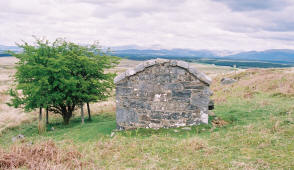
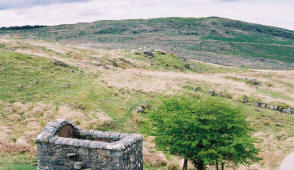
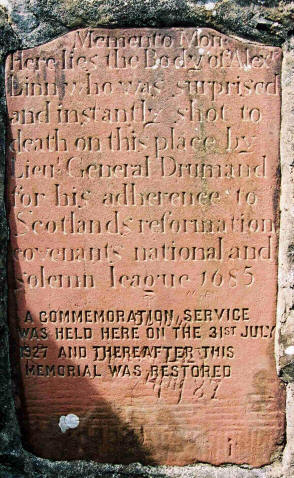
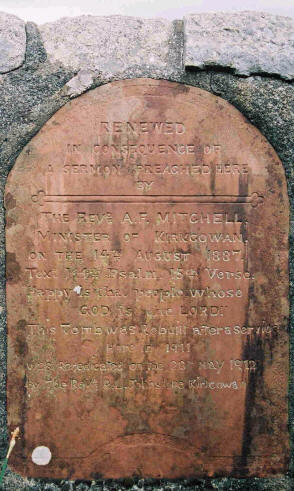
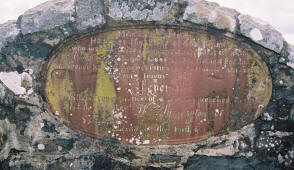
|

